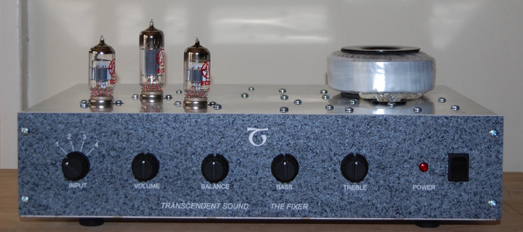
The Fixer
Line Level Control Center
With Tone and Balance Controls
You probably never realized how useful tone controls can be, until you have had the opportunity use really good ones. The passive designs of the past were not that good. They worked by boosting the signal way up, and then knocking it back down. Their action was crude, causing extreme boost at both the high and low ends. Solid state controls also have a problem. They sound like solid state controls. The best way to solve this problem is with active tube based tone controls.
The Fixer is just that. It is designed to compensate for recording equalization problems and the effects of room acoustics. It fixes things. It is not designed to provide huge alterations in the sound. It allows the user to gently alter the sound. It fine tunes the sound.
The Fixer is unity gain. Many systems have way too much gain. Connect an active preamp and the volume control never gets past 9 0:clock. Unity gain operation corrects for that condition.
Most rooms are not acoustically symmetrical. Phono cartridges have channel imbalances. People often times do not want to sit in the middle of the room, right between the speakers. The balance control provides a convenient way to adjust the acoustic center to the listener's liking.
The heart of The Fixer is the active tone control circuit. To explain its function, refer to the following charts.
Notice how the control starts at 320 Hz and then gently rises +8 dB at 80 Hz and then levels off. At 40 Hz, it starts back down. This is exactly what we want. It is not desirable to provide large bass boost at subsonic and extremely low frequencies.
The Bass Control leaves the bandwidth from roughly 400 Hz to 1 kHz unaffected. The gap is intentional so the controls do not interact with each other.
Again the control has no affect until 1.5 kHz. This preserves the gap preventing interference with the bass control. The control reaches a maximum of 8 dB at 14 kHz and then levels off. Boosting ultrasonic frequencies can interfere with sound reproduction and overload amplifiers.
We see that attenuation levels off at 11.5 k Hz. This provides a shelving effect at the high end which is highly desirable instead of greatly attenuating the treble. It cuts it down but does not eliminate it.
Noise is almost non-existant and measures below 200 microvolts, unweighted. The Fixer cannot be overloaded with line level signals. It shows no signs of clipping at 7V Rms which is +17 dB.
The Fixer is lightening fast. Bandwidth is down 1 dB at 400 kHz. It will not muddy the sound.
Output impedance is extremely low. It is highest at 100 ohms at 50 Hz, (output coupling capacitor) and steadily declines to 10 ohms at 500 Hz where it levels off. This allows it to drive long interconnect with no high frequency attenuation.
Connect it to an amplifier and you have a system. The Fixer provides high quality tube sound at a very low price. It fixes things!
Specifications:
Tubes: 1-12AU7, 1-12AX7, 1-ECC99
Bandwidth: -2 dB at 25 Hz to -1 dB at 400 kHz.
Noise: less than 200 microvolts, unweighted.
Max signal: Greater than 7 V RMS, or 17 dB.
Footprint: 14.5 inches by 10 inches.
Power: 25 watts. 120 or 230 volts, 50 to 60 Hz.
Inputs: four
Gain: unity, one
Output impedance: 10 ohms from 500 Hz on up. Increasing to 100 ohms at 50 Hz.
Shipping weight: 10 pounds.
Bass Control at maximum rotation.
0 dB +1 dB +3 dB +6 dB +8 dB +8.5 dB +7.2 dB +3 dB + 0 dB
1 kHz 320 Hz 210 Hz 125 Hz 80 Hz 65 Hz 40 Hz 20 Hz 13 Hz
Bass Control at minimum rotation
0 db -1 dB -3 dB -6 dB -9 dB -12 dB -15 dB -20 dB
1 kHz 430 Hz 270 Hz 170 Hz 110 Hz 50 Hz 20 Hz 10 Hz
Treble Control at maximum rotation
0 dB +1 dB + 3 dB +6 dB + 8 dB +8.2 dB +8.2 dB
1 kHz 1.5 kHz 2.7 kHz 5.6 kHz 14 kHz 20 k Hz 100 kHz
Treble Control at minimum rotation
0 dB -1 dB -3 dB -6 dB -8 dB -8.5 dB -9 dB -9 dB
1 kHz 1.5 kHz 2.7 kHz 5.4 kHz 11.5 kHz 20 kHz 40 kHz 100 kHz

Available as Bag-of-Parts
No chassis, no transformer,
no tubes, no screws
Everything else including wire, $349